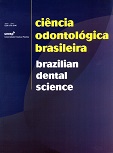Avaliação “in vitro” de materiais empregados no vedamento do terço cervical da obturação e assoalho da câmara pulpar
DOI:
https://doi.org/10.14295/bds.2007.v10i3.292Abstract
O presente estudo testou “in vitro”, a capacidade vedante de três materiais em forma de película seladora, aplicada sobre o terço cervical das obturações e assoalho da câmara pulpar, imediatamente pós-obturação de canais radiculares, visando prevenir a microinfiltração coronária, através da interface parede dentinária / material obturador do canal radicular. Utilizou-se de quarenta molares humanos com raízes completamente formadas, os canais radiculares instrumentados pela técnica de Oregon, irrigados com solução de hipoclorito de sódio a 0,5% e obturados pela técnica clássica de condensação lateral. Após a limpeza da câmara pulpar e das superfícies dentais, impermeabilizaram-se coroas e raízes com a utilização do esmalte para unhas incolor. Os dentes foram divididos aleatoriamente em quatro grupos de dez dentes, sendo um grupo controle e três grupos experimentais. Diferentes materiais foram aplicados sobre o assoalho da câmara pulpar e terço cervical das obturações de cada grupo experimental: G1- Super Bonder; G2- Esmalte para unhas; G3- Primer & Bonder 2.1; e G4- nenhum material foi aplicado. Logo após aplicação, os elementos dentários foram termociclados e imersos na tinta Nankin por um período de cinco dias. Em seguida foram então lavados, secos e o esmalte para unhas aplicado superficialmente, removido. Os espécimes foram então descalcificados, desidratados e diafanizados sendo, posteriormente, examinados por três examinadores previamente calibrados. Os resultados, após testes estatísticos, segundo técnica descritiva e inferencial (Kruskal-Wallis e Comparação Pareada), determinaram que não houve diferença estatisticamente significante entre os três materiais. Os produtos, esmalte para unhas e Super Bonder mostraram-se estatisticamente superiores ao grupo controle.
Downloads
Downloads
Published
How to Cite
Issue
Section
License
Brazilian Dental Science uses the Creative Commons (CC-BY 4.0) license, thus preserving the integrity of articles in an open access environment. The journal allows the author to retain publishing rights without restrictions.
=================




























